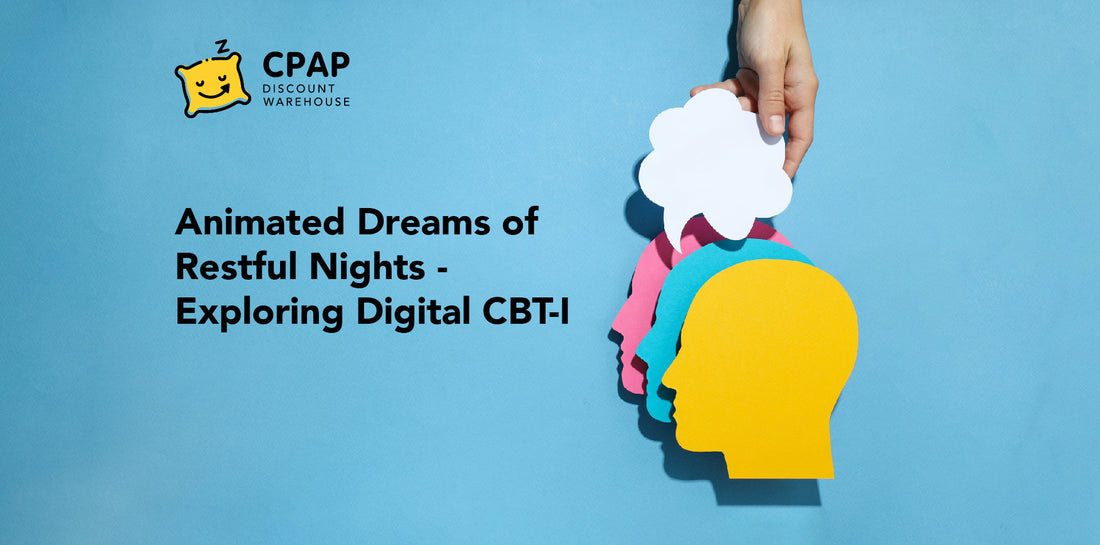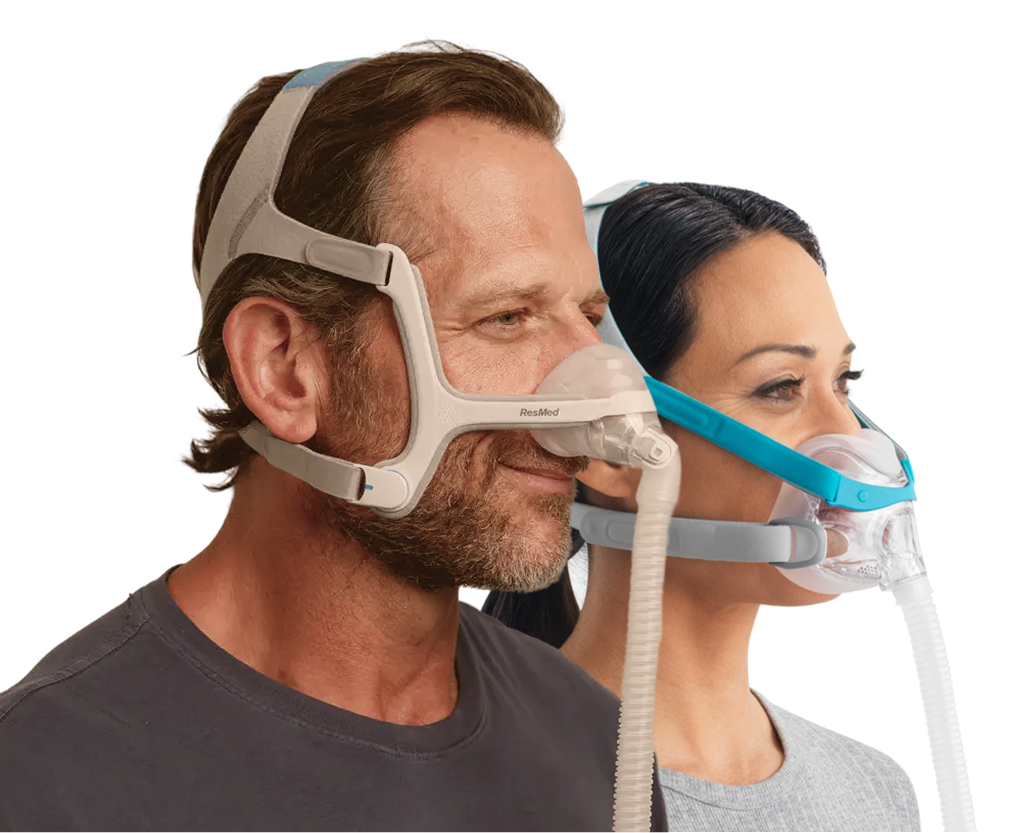Insomnia often presents many difficulties, yet effective solutions exist to improve sleep quality helping individuals drift off more quickly, remain asleep through the night, and feel energized the next day. Among the most reliable approaches is cognitive behavioral therapy for insomnia (CBT-I), which uses a brief, structured, and evidence-based process to address its troubling symptoms. In this article CPAP Discout Warehouse will provide a comprehensive overview of th principles, techniques, effectiveness, and accessibility of CBT-I.
What is CBT-I?
Insomnia is a common sleep problem that can affect anyone. About one in three people experience it at some point. Insomnia may involve difficulty falling asleep, staying asleep, waking up too early, or feeling tired throughout the day. These symptoms can make it hard to function well and affect overall health.
CBT-I works on changing the thoughts, feelings, and behaviors that are causing insomnia. Therapy techniques include managing stress, getting enough sleep, and teaching patients how to relax. CBT-I is considered effective for both short-term and chronic insomnia. Most people who try CBT-I have better sleep and less insomnia.
How does CBT-I work?
Cognitive Behavioural Therapy for Insomnia (CBT-I) is typically delivered over 6 to 8 sessions, scheduled weekly or fortnightly based on individual needs. This therapy combines several strategies to improve sleep by addressing the thoughts, behaviours, and patterns that contribute to insomnia. The key components include:
Education
Education plays an essential role in CBT-I. It helps people understand how sleep works, what insomnia is, and how it differs from other sleep difficulties. When learning about insomnia, three main factors are important:
+ Predisposing factors: underlying risks such as genetics or personal traits that increase the likelihood of insomnia.
+ Precipitating factors: triggers like stress, major life changes, irregular work schedules, or medical issues.
+ Perpetuating factors: ongoing habits that keep insomnia alive, for example going to bed too early, relying on alcohol, or using the bed for activities other than sleep or intimacy.
Education also covers sleep hygiene, which means practicing healthy sleep habits. This helps people identify and change behaviors that may be disrupting their rest, while building a consistent routine that supports better sleep.
Behavioural interventions
There are three kinds of behavioral interventions: sleep restriction, stimulus control, and relaxation training.
People with insomnia often lie awake in bed for long periods of time. Sleep restriction therapy addresses this by limiting the number of hours spent in bed, which increases the drive to sleep and can cause some daytime sleepiness. However, it is not suitable for individuals with certain medical conditions, such as bipolar disorder or seizure disorders, where reduced sleep could worsen symptoms.
Stimulus control is a strategy designed to rebuild the connection between the bed and sleep. The goal is to train the mind to associate the bedroom with rest, not wakefulness. This involves a few simple rules: use the bed only for sleeping, get up if you’re unable to fall asleep within 15–20 minutes, and reserve the bed for nighttime sleep only.
Relaxation training helps people manage stress and calm the body. Techniques may include mindful breathing, guided imagery, or progressive muscle relaxation.
If the exercise takes less than 15 minutes, it can be practiced in bed. For longer sessions, it’s best to do them outside the bedroom.
Cognitive interventions
Cognitive interventions focus on identifying and reshaping unhelpful thoughts and beliefs about sleep. Such patterns of thinking often interfere with rest, and the more sleep is disrupted, the stronger these negative thoughts can become.
>>> Sleep Apnea And Insomnia: Misdiagnosis and Differences
The Effectiveness of Digital CBT-I
CBT-I helps people fall asleep more quickly and wake up less often during the night. This improves sleep efficiency, meaning more of the time spent in bed is actually spent sleeping. Research shows that CBT-I eases insomnia symptoms in up to 80% of patients, and about 90% are able to cut back or even stop taking sleep medications. It’s also effective for people who don’t have chronic insomnia but struggle with sleep, as well as those managing mental health conditions like depression, anxiety, or post-traumatic stress disorder (PTSD), and medical issues such as cancer.
The therapy has very few side effects, and when they occur, they are usually mild such as feeling uneasy when addressing negative thoughts or changing old habits. Unlike sleeping pills, the benefits of CBT-I continue even after treatment ends, as long as the strategies are practiced. In addition to improving sleep, CBT-I has been shown to help with other conditions that often occur alongside insomnia, including depression, chronic pain, fibromyalgia, PTSD, substance use, and menopausal hot flashes.
Digital CBT-I
Similar to traditional CBT-I, digital CBT-I (dCBT-I) has proven effective for a wide range of people including adults, children, teenagers, and those living with conditions such as anxiety, depression, PTSD, substance use disorders, and certain physical health problems.
Digital programs can work in different ways. Some are designed to complement care from a sleep specialist, such as apps that monitor sleep patterns. Others are completely automated and require no outside guidance. There are also hybrid options that combine online tools with in-person support.
Here are some well-established, evidence-based digital CBT-I programs designed to help individuals manage insomnia effectively:
A Mindful Way
Developed by Dr. Giselle Withers in Australia, A Mindful Way is a 6-week online self-help program that combines CBT-I and mindfulness techniques. It is particularly beneficial for individuals who experience excessive worry at bedtime. The program includes:
+ Weekly 2-hour interactive modules (self-paced).
+ Guided readings and exercises in a structured workbook.
+ Downloadable meditation recordings for daily practice.
+ Weekly quizzes to reinforce learning.
Participants are encouraged to practice mindfulness for 15–30 minutes per day to improve sleep and reduce anxiety.
This Way Up: Managing Insomnia
This Way Up is a free, self-paced online program from Australia designed to be completed in two months. It consists of four structured lessons and can be used independently or under the supervision of a clinician (e.g., psychologist).
+ Self-help version: Fully automated, with 5-day breaks between lessons to allow time for practice.
+ Clinician-supervised version: Enables healthcare providers to monitor progress and offer support if needed.
This program provides a structured, step-by-step approach to improving sleep habits and reducing insomnia symptoms.
RESTORE
Created by Dr. Norah Vincent at Cobalt Therapeutics (USA), RESTORE is a web-based interactive program available in both English and Spanish. It is structured over seven sessions, designed to be completed within five weeks. Key features include:
+ Educational materials on sleep hygiene.
+ Practice tasks between sessions to reinforce CBT-I techniques.
+ A structured framework to help users gradually improve sleep patterns.
CBT-I Coach
CBT-I Coach is a free mobile application designed to support individuals undergoing face-to-face CBT-I therapy. Originally developed for veterans, it is now widely available for public use.
Key features of the app include:
+ Interactive sleep diary for tracking sleep patterns
+ Customizable sleep schedules, adjustable by a sleep clinician
+ Reminders for sleep hygiene practices and daily logs
+ Additional tools, including guided relaxation exercises
This app serves as a companion tool for individuals receiving CBT-I therapy, enhancing engagement and improving adherence to sleep management strategies.
Core Techniques of CBT-I
CBT-I includes various techniques that are tailored to an individual’s sleep challenges. These strategies are designed to break negative sleep patterns and promote a healthier sleep routine.
Stimulus Control Therapy: Many people with insomnia develop negative associations with their bed, leading to increased frustration and wakefulness at night. Stimulus control therapy aims to restore the bed as a place of restful sleep. Techniques include:
+ Going to bed only when sleepy.
+ Getting out of bed if unable to sleep within 20 minutes.
+ Using the bed only for sleep and intimacy (avoiding TV, eating, or working in bed).
+ Waking up at the same time every morning, even on weekends.
Sleep Restriction Therapy: People struggling with insomnia often spend excessive time in bed trying to sleep, which can reduce sleep efficiency. Sleep restriction therapy involves limiting time in bed to match actual sleep duration. This method may initially cause mild sleep deprivation, but it ultimately strengthens the body’s natural sleep drive, making sleep more efficient and restorative.
Cognitive Restructuring: Negative thoughts and anxieties about sleep can create a cycle of worry and wakefulness. Cognitive restructuring helps individuals identify and challenge these unhelpful thoughts, replacing them with healthier, more realistic beliefs about sleep.
Sleep Hygiene Education: Good sleep hygiene is essential for maintaining a healthy sleep schedule. This part of CBT-I educates individuals on lifestyle factors that influence sleep, such as:
+ Avoiding caffeine, nicotine, and alcohol close to bedtime.
+ Reducing screen time at night, as blue light from devices interferes with melatonin production.
+ Creating a comfortable sleep environment with a cool, dark, and quiet setting.
+ Establishing a relaxing bedtime routine, such as reading or meditation.
Relaxation Techniques: Stress and anxiety can significantly impact sleep quality. CBT-I incorporates relaxation methods such as:
+ Progressive muscle relaxation: Tensing and relaxing different muscle groups to reduce physical tension.
+ Deep breathing exercises: Slow, controlled breathing to promote relaxation.
+ Mindfulness meditation: Focusing on the present moment to quiet an overactive mind.

>>> Anxiety and Insomnia: Understanding the Connection
FAQs About CBT-I
Is Digital CBT-I Secure?
Yes! Reputable programs follow HIPAA and GDPR compliance to protect user data.
What If I Don’t Stay Motivated?
Most platforms use gamification, reminders, and support groups to keep users engaged.
Does It Work for Severe Insomnia?
Severe cases may require additional medical supervision, but studies show Digital CBT-I is effective for chronic insomnia.
Are There Any Side Effects?
Unlike sleep medications, Digital CBT-I has no physical side effects. The biggest challenge is adjusting to sleep restriction techniques in the beginning.






